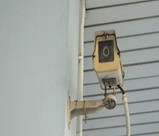
Depending on your types of customers you might not realize it, but there are still many end-user organizations using legacy analog camera systems that provide poor quality images. IP cameras offer the potential to capture and record much higher resolution images than analog cameras.
However, balancing the performance of a video system with common budget constraints has been a challenge that continues to keep many systems in the analog realm. The lower cost of analog video may allow security officers to install more cameras, but with the declining costs associated with current IP cameras, higher resolutions and system flexibility, the case for integrators to make with their customers about a move from analog to IP is stronger than ever.
The problem is that migrating customers’ surveillance systems to IP video can be complicated, because most businesses have existing infrastructure in place. Since it is costly to start over with a new infrastructure, the best course of action is to determine what to keep in place, what to replace and what can be modified. Regardless, significant time needs to be spent learning and evaluating all options so that the optimum solutions are determined and readily available.
Moving to all IP cameras does require an increased investment, but the potential benefits are numerous, can be measured, and are only going to increase the positive effects throughout the customer organization. Let’s take a look at some discussion points security providers should be having with clients when it comes to the analog vs. IP debate.
HD Analog, Hybrid or Full-on IP?
If the organization’s goal is to achieve better video quality, existing analog cameras can be upgraded to HD analog cameras. Consider also that a hybrid NVR enables organizations to use their existing analog cameras and supplement them with a few high-resolution IP cameras that provide high quality images, with the remainder of the analog cameras being gradually phased out (time frames and deadlines could be specified as part of the process).
For new sites or key locations at existing sites where the future is taken into account, consider moving to IP as soon as possible. At first glance, conversion to IP looks daunting, but during new construction the cabling infrastructure can be installed for IP cameras when the network drops for phones and computers are taking place.
The result will be a decrease in marginal costs when adding to the IP camera infrastructure. With far superior image quality and search capability, is the economic cost/benefit case for migrating to IP strong enough for your customer?
7 Reasons Why the IP Case Is Compelling
Your customers should consider the factors below and ask: “Can we afford not to go full IP for video surveillance?”
1. Today, there are many more manufacturers of IP cameras than analog cameras. With more choices available, a wider array of features and benefits, and competition to develop the next great feature set, it makes sense to choose IP over analog.
2. Many IP camera solutions are now using the contact inputs and outputs for receiving alarm events and for driving remote devices. HD analog cameras or analog cameras do not provide this.
3. Additional developments have taken place in the IP camera market over the past few years with multi-imagers that allow for an alternative to many pan/tilt/zoom (p/t/z) applications. A full coverage of the same area versus a p/t/z that covers less area with a smaller field of view is now available.
4. Reasonably priced processing power is available today, which means more advanced analytics can be performed at the edge. This allows for intelligent events, for example, involving people and/or vehicles, to be identified in the video so as to effectively reduce intrusion alarms. In addition, unique analytic data can assist both operations- and marketing-based use cases. An analog camera infrastructure cannot leverage this enormous potential.
5. Cameras are now using facial recognition (FR) functionality which is being done at the edge. Users can add such FR cameras to existing NVRs without increasing the CPU load on the recorder. This allows as many cameras as needed to be placed on the system without worrying about impacting the system’s performance.
6. Lower cost thermal IP cameras with advanced video analytics are available and being used to send alarms directly to central monitoring stations via the IP network.
7. During the next few years, the number of advanced functions that IP cameras will be able to perform, leveraging the IP network, will increase exponentially.
Customers with existing analog camera systems will need to make the decision to upgrade to HD analog to increase picture quality, or to fully migrate to IP to enjoy the myriad additional benefits available today and increasing rapidly with each passing year. Security providers can demonstrate their value helping guide clients smoothly along the path to migration.











